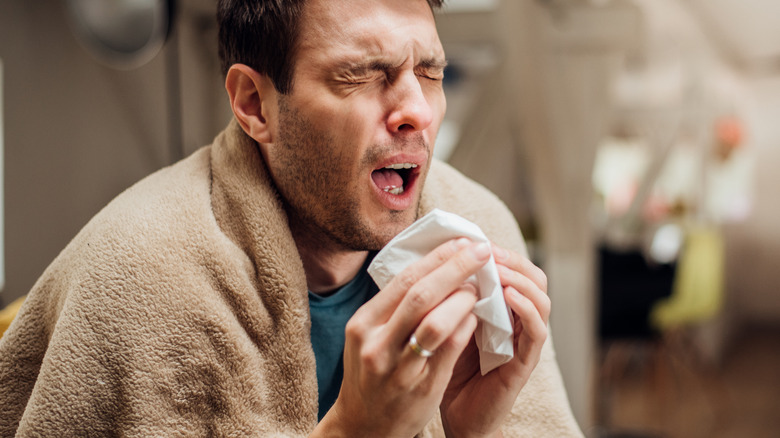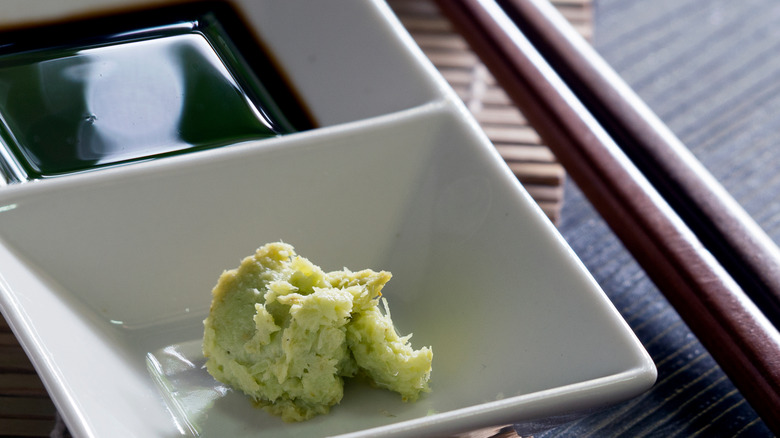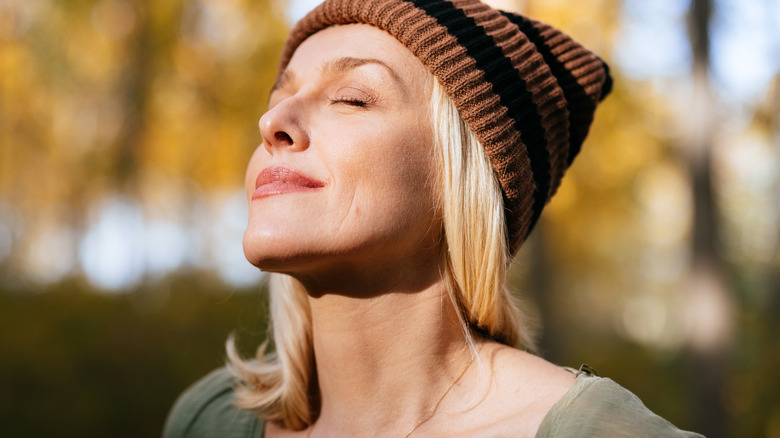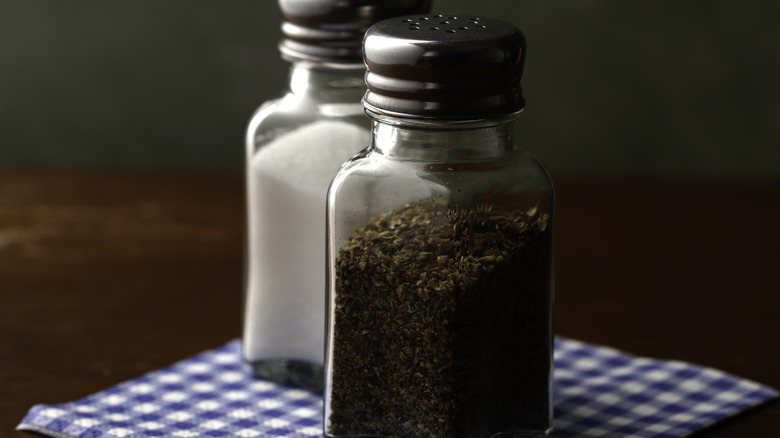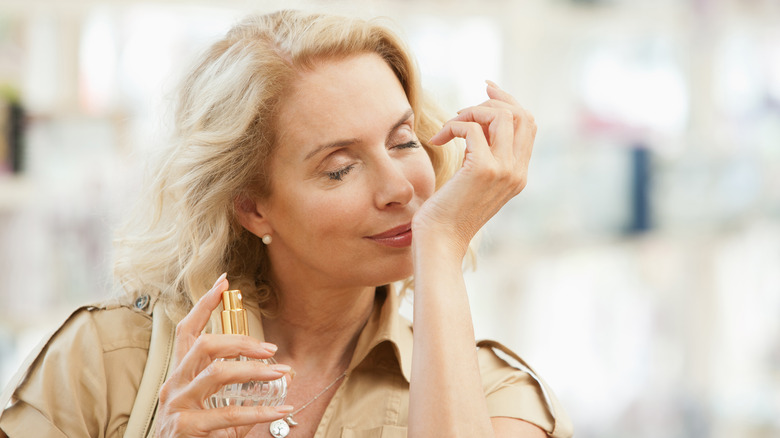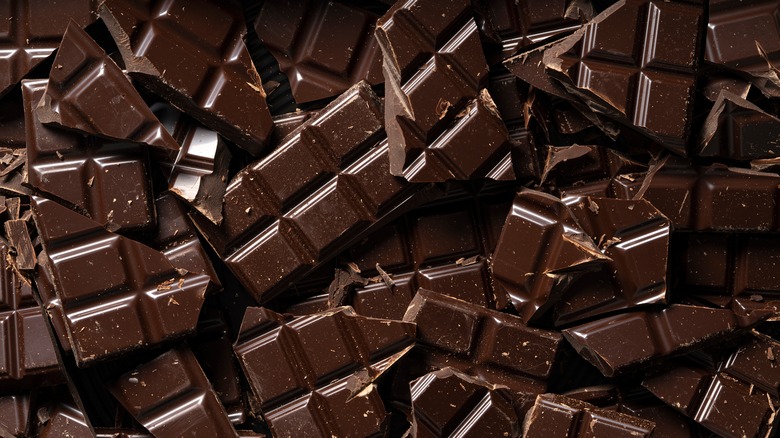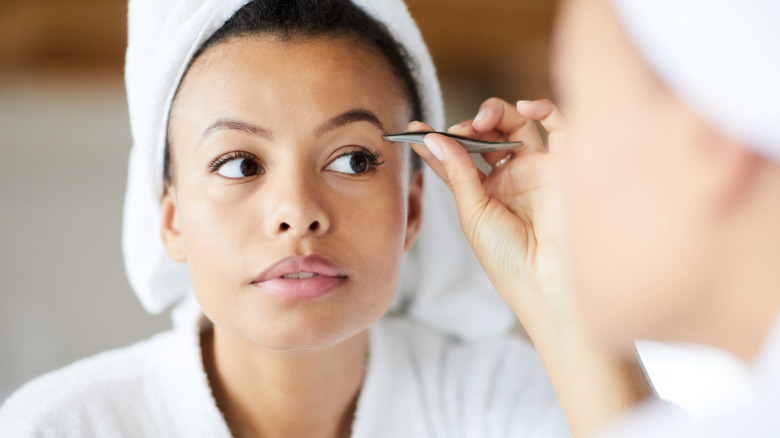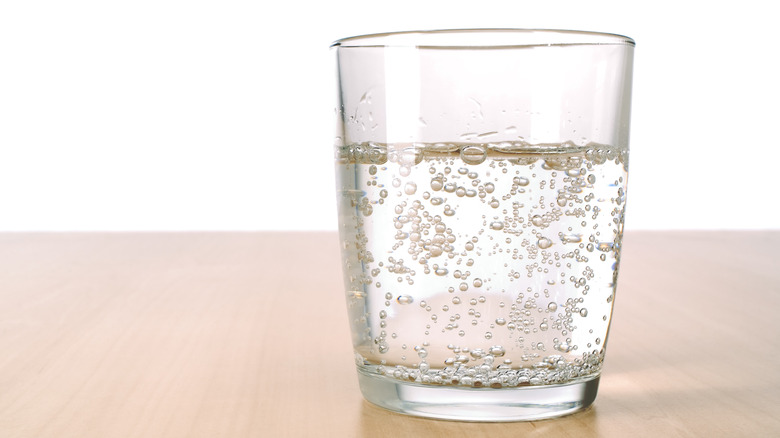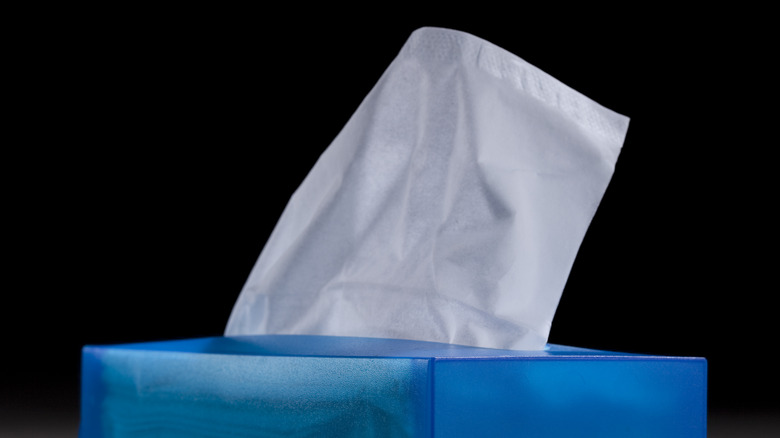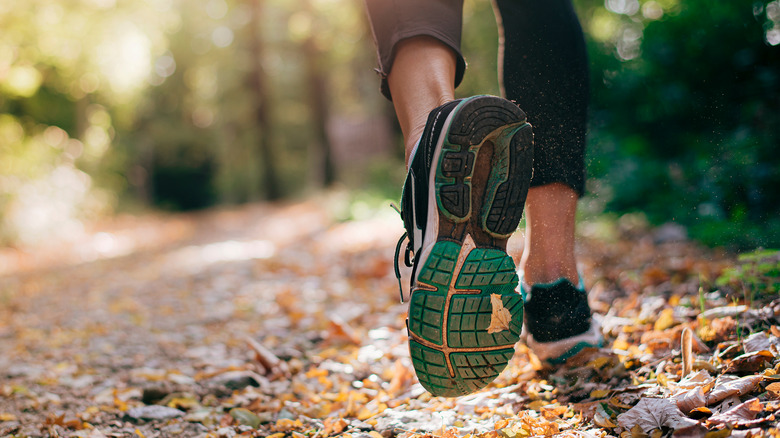Weird Ways To Make Yourself Sneeze (When You Just Can't Get It Out)
Suppressing a sneeze can feel impossible — and according to GoodRx, doing so can (albeit rarely) cause severe damage, like ruptured ear drums. But what about the opposite problem, where you feel like you need to sneeze but no sneeze is happening? While this situation isn't common, it can happen for both simple and more serious reasons (via Women's Health).
Dr. John V. Bosso, an allergist at the University of Pennsylvania Perelman School of Medicine, explained that problems sneezing could be due to a psychiatric condition. He also noted that this problem could be a sign of a brain tumor. But before you panic, those aren't the only possible causes behind an inability to sneeze. Dr. Neil Bhattacharyya, a comprehensive ear, nose, and throat specialist at Mass Eye and Ear in Boston, told Women's Health that problems sneezing could be due to the body having problems expelling something from the nose. In addition, problems sneezing could just be that you really don't need to sneeze, even though you think that you do.
With that said, there are some simple tricks that might help with a stubborn sneeze that won't happen. We'll be exploring them, as well as specific conditions that can trigger sneezing and the downsides of trying some of these potential sneeze-inducing methods. And, of course, if you are concerned that your inability to sneeze is an indication of a bigger medical problem, speak with a health care professional.
Eat a meal
As Healthline points out, we sometimes sneeze when something enters the nose (e.g., pollen). But eating can also set off sneezing in some individuals. However, what one eats and the amount eaten can both play roles in whether or not someone sneezes.
Gustatory rhinitis can also cause one to sneeze. There are mucous membranes located inside the nose, and when those membranes become inflamed, they may cause a person to sneeze. Gustatory rhinitis is a non-allergy-related form of rhinitis that can happen after eating. Specifically, certain foods like hot peppers, wasabi, and horseradish can all set off sneezing. Also, foods that are hot temperature-wise (e.g., soups) can also cause sneezing in someone with this form of rhinitis.
In addition, having a big meal might cause sneezing. WebMD notes this is because of "a related reaction" to gustatory rhinitis called snatiation (which is a blending together of "sneezing" and "satiation"). The Cleveland Clinic cautions that overeating (or eating more even though one is full) can result in such health problems as indigestion, gas, heartburn, bloating, sluggishness, nausea, and acid reflux, as well as problems with healthy weight management and eating disorders.
Step out into the sunlight
Have you ever stepped out of your home on a bright, sunny day and suddenly sneezed for no apparent reason? Well, there is a reason, and no, it's not the same thing as having a sun allergy. As the Cleveland Clinic explains, you might have ACHOO syndrome, which stands for "autosomal dominant compelling helio-ophthalmic outburst syndrome." Other terms for sneezing under these circumstances include "solar sneezes," "photoptarmosis," "sun sneezing," "photosneezia," and "photic sneeze reflex."
Whatever word or phrase you'd like to use for it, allergist Dr. David Lang noted via the Cleveland Clinic that bright light (as opposed to strictly sunlight) is the reason why some people sneeze. Also, as Healthline describes, typically it's the act of going from a darker environment into a brighter one that brings on the sneezes. In other words, someone with ACHOO syndrome could sit outside for an hour in the sun and not sneeze. But if that same person went inside a dimly lit house and then came back outside, that could result in sneezing.
Of course, sunlight isn't always an option if you feel like you need to sneeze but can't. For example, what do you do at night? However, since the key is bright light, you might want to try taking a photo of yourself using the flash on your camera. If you have ACHOO syndrome, this could trigger a sneeze (via Cleveland Clinic).
Does pepper actually make you sneeze?
We've all seen TV shows (and in particular cartoons) where a character accidentally breathes in pepper and starts sneezing uncontrollably. This isn't just an entertainment trope, though. As the Library of Congress explains, black, white, and green peppers can all trigger sneezing.
Pepper contains a compound called piperine. WebMD talks specifically about how black pepper containing piperine gives it not only its distinct flavor but also some potential healthy properties, including reducing the possibility of developing cardiovascular disease and atherosclerosis (as well as other chronic illnesses). It's been shown that piperine also helps the bloodstream absorb nutrients. These possible benefits, however, are if the piperine is ingested. Breathing it into one's nose can cause irritation. Why? Well, remember, there are nerves throughout the body, and the ends of nerves are inside the mucous membrane inside the nose. Piperine affects those nerves and can lead to sneezing.
Although breathing pepper into the nose can make one sneeze, it's important to be careful. While you might want to try a large amount of pepper to trigger that stubborn sneeze, Healthline cautions that overdoing it could lead to burning and pain instead of just sneezing. And if you happen to not have any pepper handy, Healthline notes that breathing in other spices like coriander or cumin might also bring on the sneezes.
Smell perfume
Even if you don't wear perfume except on special occasions, you might want to put a little on and breathe it in if you feel like you need to trigger a sneeze. According to WebMD, a person with nonallergic rhinitis can experience symptoms like one has with an allergy, including sneezing. Specifically, perfume is a potential sneeze-inducing trigger for patients with this form of rhinitis.
As MedlinePlus explains, there are both allergic and nonallergic versions of rhinitis. Now, if you or someone you know has nonallergic rhinitis, you might have heard the term "nonallergic rhinopathy." To clear up any confusion, nonallergic rhinopathy is a type of nonallergic rhinitis. And it's worth noting that nonallergic rhinopathy can be set off by perfumes. Specifically, MedlinePlus emphasizes how strong scents (perfumes or otherwise) can be triggers for this condition and talks about some of its other symptoms, like a runny and/or stuffy nose.
Although perfume can set off nonallergic rhinitis, keep in mind that it's also possible that perfume makes you sneeze because you have an allergy to it (via NY Allergy & Sinus Centers). In fact, a sign of allergic rhinitis can be sneezing, per NY Allergy & Sinus Centers. So, if perfume makes you sneeze, you might want to see a health care professional like an allergist and have yourself tested for a perfume allergy.
Eat or drink some dark chocolate
According to Harvard, there are two main differences between dark chocolate and milk chocolate. First, milk isn't an ingredient in dark chocolate (although this doesn't mean that cross-contamination involving milk doesn't occur). Second, the amount of cocoa solids varies, with dark chocolate having anywhere from 50% to 90% cocoa solids and milk chocolate having 10% to 50%.
Whether you prefer dark or milk chocolate, you might want to opt for dark chocolate if you're trying to trigger a sneeze. As Medical News Today explains, for some people, eating dark chocolate can result in sneezing. In addition, foods that are hot in terms of their temperature can also trigger sneezing in some individuals (via Healthline). This means a hot chocolate made from dark chocolate could give you two sneeze-inducing factors in one drink.
Besides dark chocolate possibly helping with a stubborn sneeze, Harvard notes that cocoa does contain certain chemicals that might have a positive impact on one's blood pressure. There are also studies that found that these chemicals might lower the chances of developing diabetes. However, cocoa solids also contain caffeine. WebMD cautions that too much caffeine can be bad for one's health and even dangerous. So, it's important to exercise proper portion control and take into consideration all the caffeine-containing foods that you've consumed over the course of the day.
Tweeze your eyebrows
Like washing one's face, tweezing the eyebrows can be a normal part of a daily routine. However, Mississippi Health Care points out that pulling out those eyebrow hairs could make one sneeze. And that's not the only hair located on the face that might have this effect.
According to Mississippi Health Care, the reason why tweezing eyebrow hairs can trigger sneezing is because of the nerves in your face. BBC Health specifies that it's a branch of the trigeminal nerve that causes this sneeze reaction. To understand how the trigeminal nerve works, imagine a photo of a human face. Now, imagine drawing two horizontal lines on that photo, so that the face is sectioned off into three areas: the upper part, the middle part, and the lower part. The trigeminal nerve has three branches, which send nerve impulses related to a specific part of the face: ophthalmic (scalp and upper face), maxillary (middle), and mandibular (lower), per Cleveland Clinic. However, BBC Health states that because pulling out an eyebrow hair can cause pain, it's possible for the trigeminal nerve to misinterpret that pain as a "fake sneeze signal."
In addition, Medical News Today notes that pulling out a hair from inside one of your nostrils might also trigger sneezing. However, pulling out hairs from this area can cause problems like infections, ingrown hairs, and damage to the inside of the nostrils (via Medical News Today).
Drink sparkling water
While carbonated water is another term for sparkling water, there are also specific types like mineral water, club soda, tonic water, and soda water (via WebMD). And yet, seltzer water is both another term for sparkling water, as well as a type of sparkling water. Whichever type or general name you prefer, the key thing to remember is that all sparkling waters contain bubbles made of carbon dioxide.
According to PBS, when we drink sparkling water, those carbon dioxide bubbles are turned into acid. This triggers the TRPA1 receptor in our tongues, which senses when something tastes sour. Now, of course, there are foods that have a sour taste, but our body's ability to detect when something is sour is also to alert us to potential dangers. So, when the TRPA1 receptor detects the carbon dioxide bubbles (now as acid), Paul Wise, a scientist at Monell Chemical Senses Center in Philadelphia, told PBS: "At higher levels [of stimulation], in addition to sensation, you'll get physiological defense responses designed to dilute and clear – so that is increased saliva, coughing, sneezing, tearing and also respiratory reactions."
Besides drinking sparkling water, just breathing in those carbon dioxide bubbles through the nose can be enough to trigger a sneeze (per Medical News Today). But although WebMD points out that there are possible health benefits from drinking sparkling water (like hydration), it could also cause health problems. These include dental issues because some varieties contain sweeteners.
Tickle the inside of your nose
As Dr. John V. Bosso, an allergist at the University of Pennsylvania Perelman School of Medicine, told Women's Health, sneezing can help your body rid itself of irritants. So, carefully irritating the nose is a way to make yourself sneeze.
According to Healthline, all you need to use to do this sneeze-inducing method is a tissue (and technically, not even the whole tissue). Pick a side of the tissue, roll it into a point, insert that point into either the right or the left nostril, and move the tissue point around. This motion should not only make one sneeze, but Dr. Bosso also told Women's Health that it should quickly trigger sneezing. In addition, you might want to hum while trying this method since that might help bring on sneezing.
Although you do want to aim for the back of the nostril, it's important to be careful when inserting the tissue. As Dr. Nadine M. Aktan, the assistant dean of advanced practice at the Rutgers School of Nursing, told Women's Health, "Inserting anything too far up into the nose is not recommended." Medical News Today also cautions that the tissue point can become stuck and even painful if it's inserted too far. But if you're uncomfortable with inserting a tissue into your nostril, just brushing something underneath your nose could also be an effective way to trigger a sneeze.
Exercise
As the CDC explains, physical activity done on a regular basis can have a number of health benefits, ranging from strengthening one's muscles and bones to supporting good brain health. It's also been shown to lower the chances of developing disease. And, according to Livestrong, exercise might also make you sneeze.
Specifically, someone with exercise-induced rhinitis might experience inflammation in the passages as a result of physical activity (per Livestrong). This can lead to multiple symptoms, including sneezing. Also, exercise-induced rhinitis might cause congestion, a runny nose, or itching. Furthermore, while exercising both indoors and outdoors can trigger this form of rhinitis, Healthline notes that cold, dry air is especially likely to set off exercise-induced rhinitis. So, you might be more likely to sneeze if you power walk at a park on a cool day with low humidity than if you power walk on a treadmill at the gym.
While breathing in cold, dry air while working out might trigger sneezing, Healthline cautions that exercise-induced rhinitis can also be set off by allergens in the air. Think of it this way: When you exercise, you typically increase the frequency of your breaths, via Ears, Nose, & Throat Consultants, LLC. This can mean breathing in more allergens. In addition, pollution in the air can also trigger exercise-induced rhinitis. And for anyone who enjoys swimming, be aware that the chlorine used in swimming pools could also bring on rhinitis-related symptoms.

